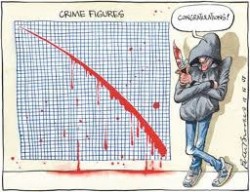 The purpose of this letter is to provide information on the process engaged by the police in producing statistics.
The purpose of this letter is to provide information on the process engaged by the police in producing statistics.
There are at least eight Police Division/Districts in New Providence in which there are at least 18 Police Stations. Complaints made by the public to the police are usually dealt with in the first instance at the station level and very often by the Central Detective Unit if the complaint is of a very serious nature, such as murder or armed robbery. Most of the complaints are made either to the Police Stations or by telephone to the Police Control Centre.
Each Police Division/District has a senior officer as its Commander, who is responsible for the classification of the crimes reported, the investigations, arrests and charges for prosecution.
The classification of the crime reported is based on the circumstances disclosed in the statements taken from the complainant and witnesses, if any. In the case of violent crimes, priority must be given to the Police Medical Report, which is received from the medical practitioner, who dealt with the victim in the first instance.
The Commanders, who classify the crimes in their districts are familiar with the law and the classifications required for the Police Statistics Unit. They are aware of the fact, that every shooting or stabbing may not be classified as an attempted murder. They use other classifications, such as; Causing Dangerous Harm, Causing Grievous Harm, Causing Harm, Maim, and Assault with Intent. These are some of the classifications I recall during my decades of service.
Murder is defined as: the intentional killing of a human being, with malice aforethought, expressed or implied. Death occurring within a year and a day.
Following are examples at shootings, and stabbings, that obviously would not be classified as attempted. “A “while playing with a gun fatally shoots B”, while walking along a street encounters a shoot-out and is struck by a stray bullet; “A” while seated in a car in an area where there is shooting is hit by a bullet, that pierces the door of the car; “A”, in an attempt to stop a fight, is stabbed by one of the fighters or “A” finds a burglar in his house and uses his gun to detain him. The burglar attacks him and is shot dead. The intention to kill, with malice is not present. Hence the classification to the lesser offences.
In many instances, Division Commanders may find that the investigation of rape cases reported are not substantiated by the evidence. The victim would have been sent to the hospital for examination. Penetration would have been proven, but the evidence obtained by the investigation may indicate consent. There are many such cases encountered by police officers. There are also many such cases where no report is made to the police, but the victim visits the hospital to protect herself from sexual disease.
Unlawful Carnal Knowledge is having sexual intercourse with girls under the age of 16 years, who cannot legally consent. There is nothing wrong if persons wish to add it to cases classified as rape. In the law, it is Unlawful Carnal Knowledge.
The Divisional Commanders have to forward to the police statistics Unit at Police Headquarters their statistics, I think each month, where it is collated and submitted to the Commissioner of Police, Executive Officers and Commanders for their information. The statisticians expands on what was received and can give information, such as; days of most killings and other crimes, locations, types of weapons and a lot of other information, that is very useful to Police Planning.
Both Messrs Ellison Greenslade and Keith Bell did exceptionally well in improving the presentation of police statistics. The young male and female officers in the Statistics Department are honest, educated hardworking professionals. I do not accept any suggestion, that they could be influenced by politicians to provide fraudulent information. I do not accept either, that any of the Divisional Commanders would be involved in such fraud or deception and I consider our Police Commissioner to be a man of integrity.
Crime statistics in the police force are divided into two distinct groups; crimes against the persons and crimes against property.
The foregoing information may indicate to your readers the variety of classifications likely to be received from at least eight commanding officers.
As far as I can recall, during the decades of my service there was never any accusations made about a Commissioner changing Police Statistics on instructions from any government. Politicians and “other” who may wish to question the veracity of Police
Statistics should request an audience with the Commissioner to examine the system and recommend any changes before denouncing the Commissioner of Police and his staff as being dishonest.
Since my enlistment in the police service in 1951, I am aware, that each year the police has to submit an annual report to the government, which contains crime statistics, suggestions for improved crime fighting, training locally and overseas, recommendations for changes in existing laws of the enactment of new laws and a host of other police matters.
Police officers have been trained and motivated to carryout the policies of the government of the day and to strenuously resist any attempt to disrupt efficiency, effectiveness and most importantly impartiality.
By: Paul Thompson Sr
Nassau, Bahamas


